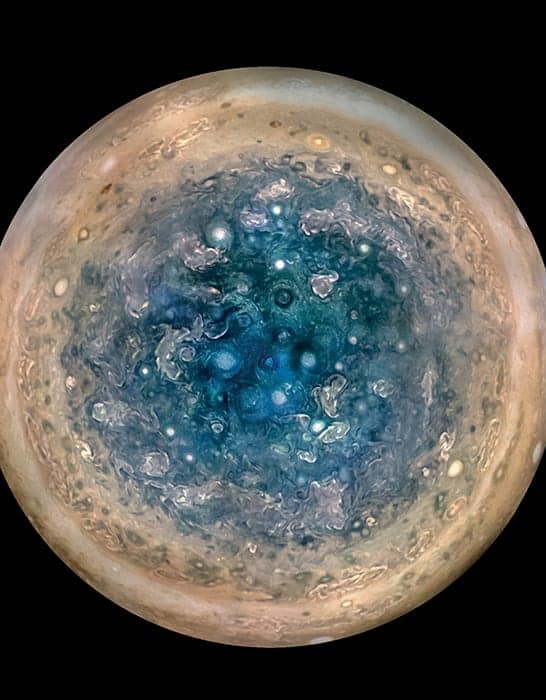We are fortunate at Physics World that the stories we cover are often highly visual. Physics and astronomy are full of eye-catching imagery and we would like to share with you some of our favourite images of 2017.

Frogs use non-Newtonian saliva to capture prey
This high-speed photograph shows a leopard frog capturing an insect. Researchers in the US have shown that this process involves shear-thinning saliva that spreads over insects when the tongue hits and then thickens and sticks when the tongue retracts. The research could lead to the development of new types of adhesives and material-handling technologies, say the scientists.

Magnetic map of Earth’s crust
This high-resolution map shows the magnetic field of the Earth’s crust in a completely new light. It was made using a new modelling technique that combined data from ESA’s Swarm satellites and their predecessor, the German CHAMP satellite. The new map highlights magnetic-filed anomalies such as one in the Central African Republic, shown above. The exact cause of this strong localized magnetic field is unknown, but the researchers speculate that it is the result of a meteor impact 540 million years ago.

can be printed using liquid glass
Tiny glass castle made by 3D printer
This is a microscope image of a glass castle measuring less than 2 mm across. It was made using a new 3D printing technique developed by researchers in Germany. By mixing a curable monomer with silicon dioxide powder, the team created a nanocomposite mixture dubbed “liquid glass”, which becomes solid under ultraviolet light. The team used the liquid glass as “ink” in a stereolithography 3D printer – a standard setup that uses laser light to solidify the printed structure. The resulting 3D composite was then heated to 1300 °C to convert it into fused silica glass.

World’s largest artificial sun fires up
This is Synlight, a new three-storey €3.5m facility that can produce light that is 10,000 times more intense than natural sunlight on Earth. Located at the German Aerospace Centre in Aachen, it consists of 149 xenon “short-arc lamps” that can be used, for example, to produce hydrogen by splitting water vapour into its constituents. When all Synlight’s lamps are focused onto an area 20 × 20 cm it can generate temperatures of around 3000 °C. With sunlight in much of Europe being unreliable and irregular, it is thought that such facilities could be used to produce fuels, with Synlight testing how to best produce them.

Jupiter’s swirling polar storms captured by Juno
This image shows swirling storms at Jupiter’s south pole and was taken by NASA’s Juno mission. Multiple pictures were taken from an altitude of 52,000 km on three separate orbits, allowing researchers to create this enhanced colour projection. Images of both poles reveal swirling storms, but the configurations of the storms are different at either pole. This could be because the poles are unstable and the nature of the storms changes over time.

Bubble cavitation spotted in liquid crystals
This time series of images shows the formation of a cavitation bubble in a flowing liquid crystal, which has been seen for the first time by physicists in Germany. This process occurs when the pressure drop in a flowing fluid is large enough to allow some of the fluid to vaporize and create a bubble. The large circle is an obstruction to the flow of a liquid crystal, which is moving from left to right. The cavitation bubble is forming at the right side of the obstruction. The discovery could be useful for developing microfluidic systems in which cavitation is used to control the rate at which different fluids mix while flowing through tiny cavities.

Gigantic X-ray “tsunami” spotted near galaxy cluster
This is a stunning X-ray image of hot gas in the Perseus galaxy cluster was captured by NASA’s Chandra X-ray Observatory. The nearby cluster is of the brightest in terms of X-ray emissions as most of its observable matter is a gas at tens of millions of degrees. There are a variety of features of the gas, including a concave “tsunami” wave twice the size of the Milky Way located towards the bottom of the image.

Virus atomic structure revealed with X-ray lasers
This colourful image is a reconstruction of the surface structure of bovine enterovirus 2, in which each colour represents a different protein. It was made using a new X-ray diffraction technique that avoids damage to the fragile proteins, which can be caused by X-ray lasers. The technique was developed by researchers in the US, who were able to collect enough data within 14 min at room temperature to determine the structure of the virus down to 0.23 nm.

Sculpture inspired by neutrino lab unveiled
This sculpture is inspired by the geometry of the neutrino detector at the Sudbury Neutrino Observatory (SNO) and earlier this year it was unveiled at Queen’s University in Kingston, Canada. SNO, which operated from 1999 to 2006, was located 2.1 km underground and detected neutrinos from the Sun through their interactions with a large tank of heavy water. Created by the mathematician George Hart from the State University of New York, the sculpture is about 1.5::m in diameter and made of 30 identical, laser-cut, wood components, as well as six brass rods. “I was struck by the fact that both the mass of the Sun and the mass of water in the SNO detector are balls of fluids,” says Hart. “So the body of the sculpture conveys a sense of fluidity with its swirling 5-fold vortices.”

Tiny flag celebrates Canada’s sesquicentenary
We stay in Canada for the final image, which is probably the smallest Canadian flag ever. Measuring just one-hundredth the width of a human hair. It was made by Travis Casagrande at McMaster University to celebrate the 150th anniversary of Canada. He used a focused ion beam microscope to etch the free-standing 3D flag – complete with a flagpole – into a penny.


